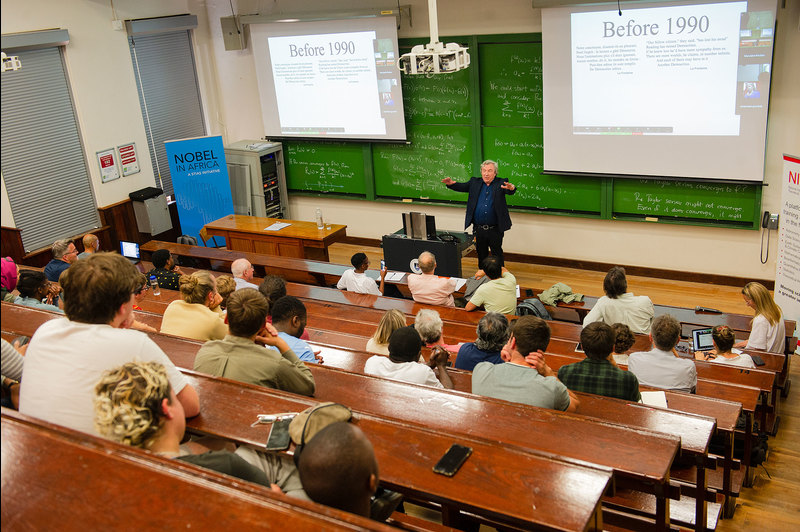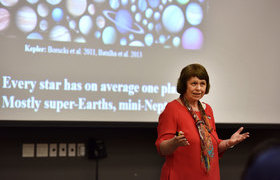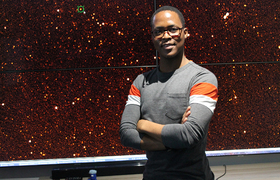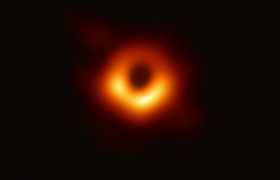Nobel in Africa at UCT
31 October 2022 | Story Nicole Forrest. Photo Lerato Maduna. Read time 6 min.
On Thursday, 20 October, as part of the Nobel in Africa symposia series, the University of Cape Town’s (UCT) Department of Mathematics and Applied Mathematics (MAM) hosted Professor Viatcheslav Mukhanov for a public lecture on his work in cosmology and theory of the quantum universe.
Nobel in Africa is a Stellenbosch Institute for Advanced Studies (STIAS) initiative, presented in partnership with Stellenbosch University and with the support of the Nobel Foundation and the Royal Swedish Academy of Sciences.
The programme, which is funded by the Knut & Alice Wallenberg Foundation, is aimed at promoting areas of science in which breakthroughs are occurring or which have cultural or social significance. According to STIAS, the talks “provide a unique opportunity to support and showcase advanced research and scholarship on the African continent”.
“Our vision is to advance scholarship across all disciplines and invest in an intellectual future of the African continent.”
The initiative aims to provide opportunities for sharing innovative, high-level scholarship, especially as it pertains to promoting research excellence and collaborative scholarship in Africa.
In his opening address at the official launch of the Nobel in Africa programme on Tuesday, 25 October, the director of STIAS, Professor Edward Kirumira, noted that it was this goal and its alignment with the Stellenbosch-based institute that drove establishment of this partnership.
“Our vision is to advance scholarship across all disciplines and invest in an intellectual future of the African continent in conversation with the other world-renowned scientists and creative artists,” he said.
Bringing together experts from Africa and the world
For the first time, Nobel in Africa is providing platforms for public lectures and critical engagements with universities around the Western Cape this year.
“The Nobel in Africa symposium series is an initiative that will bring together experts in Africa and the world for discussions about science and the advancement of research in the areas of physics, chemistry, economic sciences and physiology and medicine,” said Professor Amanda Weltman of the MAM.
“The series aims to provide leading scientists in Africa with the opportunity to interact with the international community on our own soil.
“The Nobel Foundation has been hosting symposia around the Nobel Prizes since 1965, but this is the first time that an external organisation is hosting, and the High Energy Physics, Cosmology & Astrophysics Theory Group at UCT are delighted to play a role as hosts.”
As part of this public outreach initiative, the group hosted the UCT Nobel in Africa Seminar given by the Russian-born Professor Mukhanov.
A full professor of physics and head of the Astroparticle Division at the Ludwig Maximilians Universität in Munich, Germany, Mukhanov is a leader in the field of cosmology. He is best known for his theory of the quantum origin of the universe structure, which was born out of research he completed with fellow cosmologist Gennady Chibisov (1946–2008).
This research, which the pair published in 1981, formed the basis of Mukhanov’s outreach seminar. The professor discussed recent developments in cosmology that have arisen as a result of new cosmic microwave background fluctuation measurement techniques that enabled experiments to be carried out based on his theory.
Theorising the formation of the universe
When Mukhanov was completing his PhD at the Moscow Institute of Physics and Technology, cosmology theorists began to run into problems with the Big Bang Theory. Although compelling evidence had been found to support the theory in the mid-1960s, the consensus among scientists was that the homogeneity of the observed universe on a massive scale was extremely unlikely – if not impossible.
Inspired by the work of Alexei Starobinsky, which focused on the origins of the Big Bang universe and found that it would have likely expanded exponentially in its first moments of existence, Mukhanov and Chibisov set about trying to understand why the universe is so uniform.
They posited that exponential expansion would explain the homogeneity we observe across the universe. However, they also realised that this uniformity was at odds with Heisenberg’s uncertainty principle.
“The idea was that there had to be small inhomogeneities in the matter when the Big Bang occurred.”
The idea was that there had to be small inhomogeneities in the matter when the Big Bang occurred. With the exponentially rapid expansion of the universe, these minute quantum fluctuations would be stretched to an extremely large size, grow in amplitude and become the basis for the formation of galaxies.
Mukhanov and Chibisov concluded that these inhomogeneities – or primordial wiggles, as Mukhanov calls them – would themselves constitute the universe. They would be the structures that give the universe substance rather than simply being empty space.
Several other scientists came up with similar theories, but it was Mukhanov who developed a hypothesis relating to these fluctuations that was applicable to a variety of cosmic inflation models.
Although calculations evidenced that such inhomogeneities would be detectable in the cosmic microwave background, it would be decades before technology would enable monitoring of this radiation. Finally, in the past 20 years, these observations became possible and there have been a number that have validated Mukhanov’s theoretical predictions.
The 2022 Nobel in Africa symposia series is themed “Predictability in Science in the Age of AI”. It took place at the STIAS Wallenberg Research Centre in Stellenbosch from 24 to 28 October.
 This work is licensed under a Creative Commons Attribution-NoDerivatives 4.0 International License.
This work is licensed under a Creative Commons Attribution-NoDerivatives 4.0 International License.
Please view the republishing articles page for more information.










